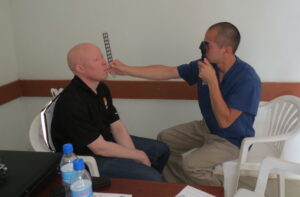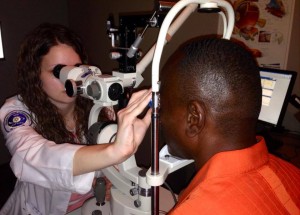I was always curious as to why so many optometrists have Master of Public Health (MPH) degrees. I used to wonder, what does public health have to do with optometry? I’ve come to learn that the answer is probably more obvious than you may think…
I’m sure every optometry student has engaged in the following conversation: “Oh, so you’re an optometry student. That’s great! What’s the difference between an optometrist and an ophthalmologist?”
I would be lying if I said that the question doesn’t annoy me at times, but the fact of the matter is that we can’t blame the public for not knowing who we are. Educating the general public about optometry is a part of public health! Our identity is important as we transition from students to licensed optometrists.

How can we as students educate our future patients and promote our profession?
1. Get Involved With Public Health
What exactly is public health? According to the WHO, “Public health refers to all organized measures (whether public or private) to prevent disease, promote health, and prolong life among the population as a whole.” By focusing on preventative care, we can prevent events that can affect the quality of life of our potential patients. Vision, particularly the lack thereof, greatly affects one’s quality of life, and as future ODs we can preserve it with simple and effective patient education.
2. Get Involved With Interdisciplinary Practices and Community Health Centers
Dentists, MDs, ophthalmologists, and other health practitioners will never know our abilities in terms of patient care if optometrists and optometry students don’t show them. We are excellent resources for disease co-management, and the best way to educate is to illustrate. Working alongside our colleagues in the health profession is the best way to display what we can bring to the table, for health professionals and for the patients we serve.
3. Get Involved With Optometry
As cliché as it may sound, becoming involved with optometric associations is an exciting and rewarding way to educate the average person about optometry. Joining an organization such as the AOSA is more than just attending Optometry’s Meeting. The AOSA represents a  body of students who are working towards a common goal: advocacy. We need a voice to speak up for us—and that voice is ours.
body of students who are working towards a common goal: advocacy. We need a voice to speak up for us—and that voice is ours.
4. Get Involved—Spread the Word!
The best person to explain what an optometrist does is an optometrist! We must be our own advocates, spreading the word about the importance of vision care and the preservation of sight. So the next time you’re in a taxi, or chatting with the TSA agent at the airport, I urge you to ask them: “When was your last eye exam?” I can guarantee that you will teach them something in the conversation that follows.
As students, our professors can drown us in information about diseases and protocols for diagnosis, treatment, and management…but before we grab our ophthalmoscopes, we must remember that educating our patients is a huge responsibility that we must embrace! Some of the information will come from your Kanski book—but some of the most valuable information will come from your professional involvement.
So what does public health have to do with optometry? They both have one very important thing in common: our patients.
Get Involved Today!

